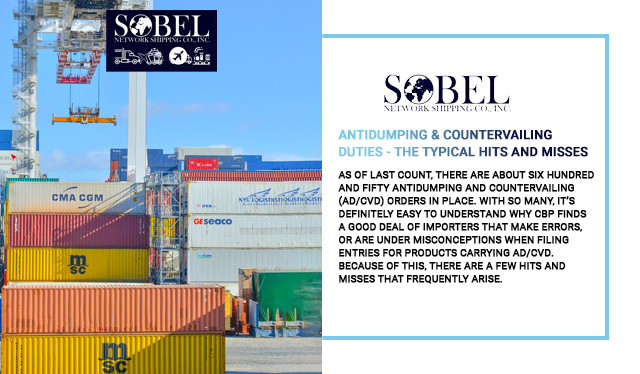As of last count, there are about six hundred and fifty antidumping and countervailing (AD/CVD) orders in place. With so many, it’s definitely easy to understand why CBP finds a good deal of importers that make errors, or are under misconceptions when filing entries for products carrying AD/CVD. Because of this, there are a few hits and misses that frequently arise.
Timing. It’s often unclear to importers when AD/CVD first become due. To eliminate confusion, CBP collects as follows: The agency suspends every entry liquidation and collects AD/CVD cash deposits. This starts from the Department of Commerce’s publication of its first affirmative determination which is typically preliminary. There are critical circumstances, however, and CBP can go back 90 days from publication to collect cash deposits. Once the provisional measures expire, CBP will resume duty collection if Commerce publishes an AD/CVD order. There is however, 120 days leniency, with up to 180 day extension for AD cases.
The next hit or miss is updates. It’s always critical to review CBP messages and notices providing updates to AD/CVD rates and liquidation as they change regularly due to reviews. When CBP suspends entries and importers for months at a time, it more often than not comes as a surprise when Commerce instructs CBP to liquidate at a rate typically different from one under which deposits had been made. These scope changes can occur even more frequently and can cut both ways, placing particular products within or outside of orders.
Next is accuracy. When importers provide wrong case numbers, either just AD or just CVD case (but not both when both are necessary or applicable), or just put the completely incorrect manufacturer ID number; it results in the CBP needing to re-liquidate the entry, issue a duty demand, and / or levy penalties for failure to tender the correct AD/CVD at entry.
And lastly, is opportunities. Once merchandise is released from CBP custody, the importer is not entitled to an AD/CVD refund. Unless an overpayment of duties is made or a subsequent decrease in the rate from an administrative review happens. CBP regulations also prohibit drawbacks. Often failing to take advantage of placing AD/CVD covered merchandise into bonded warehouses or foreign trade zones and exporting them directly out of the US, importers miss out on lawfully avoiding AD/CVD. Placing AD/CVD goods in bonded warehouses may allow you to postpone entry until a lower rate or even when no rate applies.
As is the case with any industry, there are always hits and misses. Considering these tips might just save you a lot of money when dealing with the exposure issues of AD/CVD. And here at Sobel, we can help you with the minute details of navigating classifications and potential AD/CVD issues based on commodity and country of origin.
There are few things worse than having to go back and pay additional duty for a product long since imported and having to alter your overall landed cost and the potential reduced profitability. Our licensed customs brokers are focused on getting all the details prior to importation to prevent unwanted surprises, especially now when it feels like every shipment is overdue and desperately needed.


